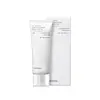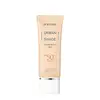What's inside
What's inside
 Key Ingredients
Key Ingredients

 Benefits
Benefits

 Concerns
Concerns

 Ingredients Side-by-side
Ingredients Side-by-side

Water
Skin ConditioningZinc Oxide
Cosmetic ColorantDibutyl Adipate
EmollientCyclohexasiloxane
EmollientDipropylene Glycol
HumectantDicaprylyl Carbonate
EmollientPropylheptyl Caprylate
EmollientButyloctyl Salicylate
Skin ConditioningCetyl Diglyceryl Tris(Trimethylsiloxy)Silylethyl Dimethicone
Emulsion StabilisingNiacinamide
SmoothingCaprylyl Methicone
Skin ConditioningMethyl Methacrylate Crosspolymer
Diethylamino Hydroxybenzoyl Hexyl Benzoate
UV FilterBis-Ethylhexyloxyphenol Methoxyphenyl Triazine
Skin ConditioningEthylhexyl Triazone
UV AbsorberCalcium Aluminum Borosilicate
Polyglyceryl-3 Polydimethylsiloxyethyl Dimethicone
Skin ConditioningPolymethylsilsesquioxane
Titanium Dioxide
Cosmetic ColorantDisteardimonium Hectorite
StabilisingMagnesium Sulfate
Triethoxycaprylylsilane
1,2-Hexanediol
Skin ConditioningPhenyl Trimethicone
Skin ConditioningOenothera Biennis Flower Extract
AstringentUlmus Davidiana Root Extract
Skin ConditioningPinus Palustris Leaf Extract
TonicPueraria Lobata Root Extract
HumectantAcrylates/Dimethicone Copolymer
Skin ConditioningPolyglyceryl-6 Polyricinoleate
EmulsifyingGlyceryl Caprylate
EmollientCaprylyl Glycol
EmollientEthylhexylglycerin
Skin ConditioningAdenosine
Skin ConditioningSodium Hyaluronate
Humectant4-Terpineol
MaskingSilica
AbrasiveTocopherol
AntioxidantWater, Zinc Oxide, Dibutyl Adipate, Cyclohexasiloxane, Dipropylene Glycol, Dicaprylyl Carbonate, Propylheptyl Caprylate, Butyloctyl Salicylate, Cetyl Diglyceryl Tris(Trimethylsiloxy)Silylethyl Dimethicone, Niacinamide, Caprylyl Methicone, Methyl Methacrylate Crosspolymer, Diethylamino Hydroxybenzoyl Hexyl Benzoate, Bis-Ethylhexyloxyphenol Methoxyphenyl Triazine, Ethylhexyl Triazone, Calcium Aluminum Borosilicate, Polyglyceryl-3 Polydimethylsiloxyethyl Dimethicone, Polymethylsilsesquioxane, Titanium Dioxide, Disteardimonium Hectorite, Magnesium Sulfate, Triethoxycaprylylsilane, 1,2-Hexanediol, Phenyl Trimethicone, Oenothera Biennis Flower Extract, Ulmus Davidiana Root Extract, Pinus Palustris Leaf Extract, Pueraria Lobata Root Extract, Acrylates/Dimethicone Copolymer, Polyglyceryl-6 Polyricinoleate, Glyceryl Caprylate, Caprylyl Glycol, Ethylhexylglycerin, Adenosine, Sodium Hyaluronate, 4-Terpineol, Silica, Tocopherol
Water
Skin ConditioningTitanium Dioxide
Cosmetic ColorantPhenyl Trimethicone
Skin ConditioningButylene Glycol
HumectantButyloctyl Salicylate
Skin ConditioningCyclopentasiloxane
EmollientGlycerin
HumectantIsododecane
EmollientPolyglyceryl-4 Diisostearate/Polyhydroxystearate/Sebacate
EmulsifyingButylene Glycol Dicaprylate/Dicaprate
EmollientNiacinamide
SmoothingDimethicone
EmollientPolymethyl Methacrylate
Polyglyceryl-3 Polyricinoleate
EmulsifyingPolymethylsilsesquioxane
Sodium Chloride
MaskingCI 77492
Cosmetic ColorantDisteardimonium Hectorite
StabilisingTrimethylsiloxysilicate
EmollientDimethicone/Vinyl Dimethicone Crosspolymer
Skin ConditioningSorbitan Isostearate
EmulsifyingAluminum Hydroxide
EmollientSorbitan Sesquioleate
EmulsifyingSynthetic Beeswax
Emulsion StabilisingMica
Cosmetic ColorantPropanediol
SolventPortulaca Oleracea Extract
Skin ConditioningStearic Acid
CleansingPanthenol
Skin ConditioningDisiloxane
Skin ConditioningTriethoxycaprylylsilane
Sodium Benzoate
MaskingCI 77491
Cosmetic ColorantTrimethylsiloxysilicate/Dimethiconol Crosspolymer
Propylene Carbonate
SolventPotassium Sorbate
PreservativeSilica
AbrasiveBetula Platyphylla Japonica Juice
Skin ConditioningPolyhydroxystearic Acid
EmulsifyingArtemisia Vulgaris Oil
PerfumingDisodium EDTA
CI 77499
Cosmetic ColorantAdenosine
Skin ConditioningDisodium Stearoyl Glutamate
CleansingEthylhexyl Palmitate
EmollientIsopropyl Myristate
EmollientIsostearic Acid
CleansingLecithin
EmollientHyaluronic Acid
HumectantHydrolyzed Hyaluronic Acid
HumectantSodium Hyaluronate
Humectant1,2-Hexanediol
Skin ConditioningAdansonia Digitata Seed Extract
Skin ConditioningEquisetum Arvense Extract
AstringentOlea Europaea Leaf Extract
PerfumingVaccinium Macrocarpon Fruit Extract
AstringentFructan
Skin ConditioningOpuntia Ficus-Indica Extract
Skin ConditioningWater, Titanium Dioxide, Phenyl Trimethicone, Butylene Glycol, Butyloctyl Salicylate, Cyclopentasiloxane, Glycerin, Isododecane, Polyglyceryl-4 Diisostearate/Polyhydroxystearate/Sebacate, Butylene Glycol Dicaprylate/Dicaprate, Niacinamide, Dimethicone, Polymethyl Methacrylate, Polyglyceryl-3 Polyricinoleate, Polymethylsilsesquioxane, Sodium Chloride, CI 77492, Disteardimonium Hectorite, Trimethylsiloxysilicate, Dimethicone/Vinyl Dimethicone Crosspolymer, Sorbitan Isostearate, Aluminum Hydroxide, Sorbitan Sesquioleate, Synthetic Beeswax, Mica, Propanediol, Portulaca Oleracea Extract, Stearic Acid, Panthenol, Disiloxane, Triethoxycaprylylsilane, Sodium Benzoate, CI 77491, Trimethylsiloxysilicate/Dimethiconol Crosspolymer, Propylene Carbonate, Potassium Sorbate, Silica, Betula Platyphylla Japonica Juice, Polyhydroxystearic Acid, Artemisia Vulgaris Oil, Disodium EDTA, CI 77499, Adenosine, Disodium Stearoyl Glutamate, Ethylhexyl Palmitate, Isopropyl Myristate, Isostearic Acid, Lecithin, Hyaluronic Acid, Hydrolyzed Hyaluronic Acid, Sodium Hyaluronate, 1,2-Hexanediol, Adansonia Digitata Seed Extract, Equisetum Arvense Extract, Olea Europaea Leaf Extract, Vaccinium Macrocarpon Fruit Extract, Fructan, Opuntia Ficus-Indica Extract
 Reviews
Reviews

Ingredients Explained
These ingredients are found in both products.
Ingredients higher up in an ingredient list are typically present in a larger amount.
1,2-Hexanediol is a synthetic liquid and another multi-functional powerhouse.
It is a:
- Humectant, drawing moisture into the skin
- Emollient, helping to soften skin
- Solvent, dispersing and stabilizing formulas
- Preservative booster, enhancing the antimicrobial activity of other preservatives
Adenosine is in every living organism. It is one of four components in nucleic acids that helps store our DNA.
Adenosine has many benefits when used. These benefits include hydrating the skin, smoothing skin, and reducing wrinkles. Once applied, adenosine increases collagen production. It also helps with improving firmness and tissue repair.
Studies have found adenosine may also help with wound healing.
In skincare products, Adenosine is usually derived from yeast.
Learn more about AdenosineButyloctyl Salicylate is a chemical UV filter structurally similar to octisalate. It is a photostabilizer, SPF booster, emollient and solvent. This ingredient helps evenly spread out ingredients.
According to a manufacturer, it is suitable for pairing with micro Titanium Dioxide, Zinc Oxide, and pigments.
Photostabilizers help stabilize UV-filters and prevents them from degrading quickly.
Learn more about Butyloctyl SalicylateDisteardimonium Hectorite comes from the clay mineral named hectorite. It is used to add thickness to a product.
It can also help stabilize a product by helping to disperse other ingredients.
Hectorite is a rare, white clay mineral.
Learn more about Disteardimonium HectoriteNiacinamide is a multitasking form of vitamin B3 that strengthens the skin barrier, reduces pores and dark spots, regulates oil, and improves signs of aging.
And the best part? It's gentle and well-tolerated by most skin types, including sensitive and reactive skin.
You might have heard of "niacin flush", or the reddening of skin that causes itchiness. Niacinamide has not been found to cause this.
In very rare cases, some individuals may not be able to tolerate niacinamide at all or experience an allergic reaction to it.
If you are experiencing flaking, irritation, and dryness with this ingredient, be sure to double check all your products as this ingredient can be found in all categories of skincare.
When incorporating niacinamide into your routine, look out for concentration amounts. Typically, 5% niacinamide provides benefits such as fading dark spots. However, if you have sensitive skin, it is better to begin with a smaller concentration.
When you apply niacinamide to your skin, your body converts it into nicotinamide adenine dinucleotide (NAD). NAD is an essential coenzyme that is already found in your cells as "fuel" and powers countless biological processes.
In your skin, NAD helps repair cell damage, produce new healthy cells, support collagen production, strengthen the skin barrier, and fight environmental stressors (like UV and pollution).
Our natural NAD levels start to decline with age, leading to slower skin repair, visible aging, and a weaker skin barrier. By providing your skin niacinamide, you're recharging your skin's NAD levels. This leads to stronger, healthier, and younger looking skin.
Another name for vitamin B3 is nicotinamide. This vitamin is water-soluble and our bodies don't store it. We obtain Vitamin B3 from either food or skincare. Meat, fish, wheat, yeast, and leafy greens contain vitamin B3.
The type of niacinamide used in skincare is synthetically created.
Learn more about NiacinamidePhenyl Trimethicone is a silicon-based polymer. It is derived from silica.
Phenyl Trimethicone is used as an emollient and prevents products from foaming.
As an emollient, it helps trap moisture in the skin. It is considered an occlusive.
Learn more about Phenyl TrimethiconePolymethylsilsesquioxane is a silicone used as a film forming agent.
When applied to the skin, this ingredient creates an invisible film on the surface. This film still allows oxygen to pass through, but prevents moisture from escaping. This can help condition and hydrate the skin. It also leaves a silky feel when applied.
Polymethylsilsesquioxane has not been shown to clog pores. It has been deemed safe to use up to 55%, but most cosmetics use much less.
If you have concerns about using this ingredient, we recommend speaking with a professional.
Learn more about PolymethylsilsesquioxaneSilica, also known as silicon dioxide, is a naturally occurring mineral. It is used as a fine, spherical, and porous powder in cosmetics.
Though it has exfoliant properties, the function of silica varies depending on the product.
The unique structure of silica enhances the spreadability and adds smoothness, making it a great texture enhancer.
It is also used as an active carrier, emulsifier, and mattifier due to its ability to absorb excess oil.
In some products, tiny microneedles called spicules are made from silica or hydrolyzed sponge. When you rub them in, they lightly polish away dead skin layers and enhance the penetration of active ingredients.
Learn more about SilicaSodium Hyaluronate is hyaluronic acid's salt form. It is commonly derived from the sodium salt of hyaluronic acid.
Like hyaluronic acid, it is great at holding water and acts as a humectant. This makes it a great skin hydrating ingredient.
Sodium Hyaluronate is naturally occurring in our bodies and is mostly found in eye fluid and joints.
These are some other common types of Hyaluronic Acid:
Learn more about Sodium HyaluronateTitanium dioxide is a mineral UV filter widely used in sunscreens and cosmetics.
It is one of only two UV filters officially classified as “mineral” by regulatory agencies, the other being zinc oxide.
Titanium dioxide provides broad-spectrum protection mostly in the UVB and UVAII range, with some protection in the UVAI range.
While its UVA protection isn’t as strong as zinc oxide’s, the difference is minor.
A common myth is that mineral UV filters reflect UV light. However, modern research shows titanium dioxide absorbs UV radiation like chemical filters (~95% absorption & 5% reflection).
Thanks to its non-irritating nature, titanium dioxide is suitable for sensitive, acne-prone, or redness-prone skin. It is unlikely to cause "eye sting" like other sunscreen ingredients.
A major drawback of this ingredient is its white cast and thick texture. This is why mineral sunscreens often leave a white cast and are less cosmetically elegant than chemical/hybrid sunscreens.
To improve white cast and spreadability, micronized or nano-sized titanium dioxide is often used.
There are ongoing concerns surrounding nano-titanium oxide's impact on marine ecosystems.
There is no conclusive evidence that any form of titanium oxide (or any other sunscreen ingredients) will cause harm to marine ecosystems or coral reefs. The science is still developing but many consumers are keeping a close eye on this issue.
Please note, many destinations have reef-safety sunscreen rules. For instance, the U.S. Virgin Islands advises all visitors to use non-nano mineral sunscreens.
Nano mineral sunscreens once raised safety concerns about absorption into skin.
Extensive research has shown that they do not penetrate healthy or damaged skin; they remain safely on the surface and the top layer of dead skin (stratum corneum).
You'll likely find titanium dioxide bundled with alumina, silica, or dimethicone. These ingredients help make titanium dioxide highly photostable; this prevents it from interacting with other formula components under UV light.
Learn more about Titanium DioxideTriethoxycaprylylsilane is a silicone used to bind and stabilize ingredients.
As an emulsifier, it helps prevent ingredients from separating. This can help elongate the shelf life of products.
Triethoxycaprylylsilane is often used to coat mineral sunscreens ingredients to help give a better feel. It also helps reduce oxidative stress in sunscreens.
Learn more about TriethoxycaprylylsilaneWater. It's the most common cosmetic ingredient of all. You'll usually see it at the top of ingredient lists, meaning that it makes up the largest part of the product.
So why is it so popular? Water most often acts as a solvent - this means that it helps dissolve other ingredients into the formulation.
You'll also recognize water as that liquid we all need to stay alive. If you see this, drink a glass of water. Stay hydrated!
Learn more about Water